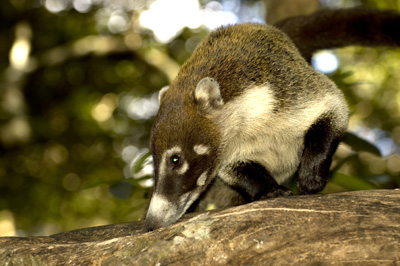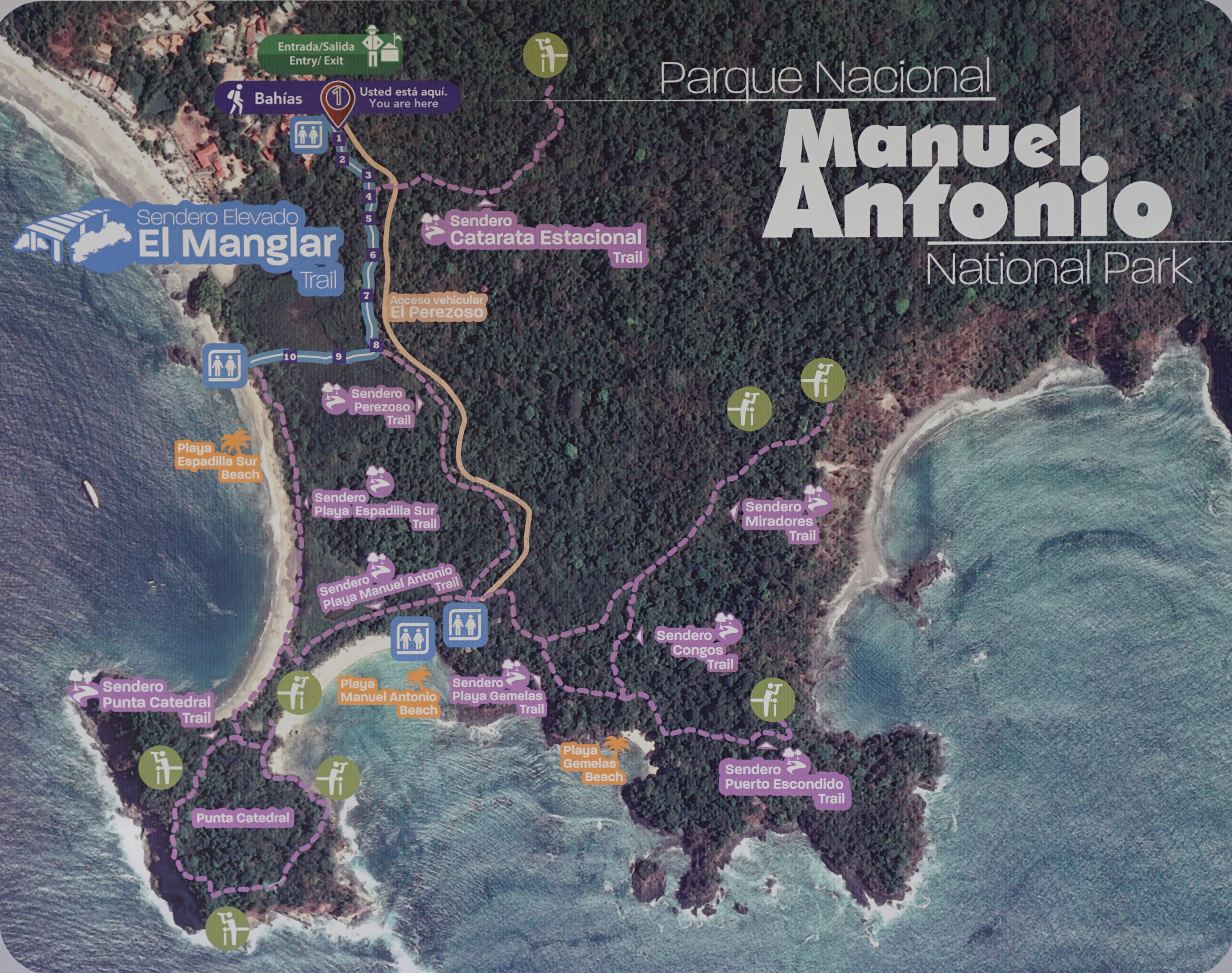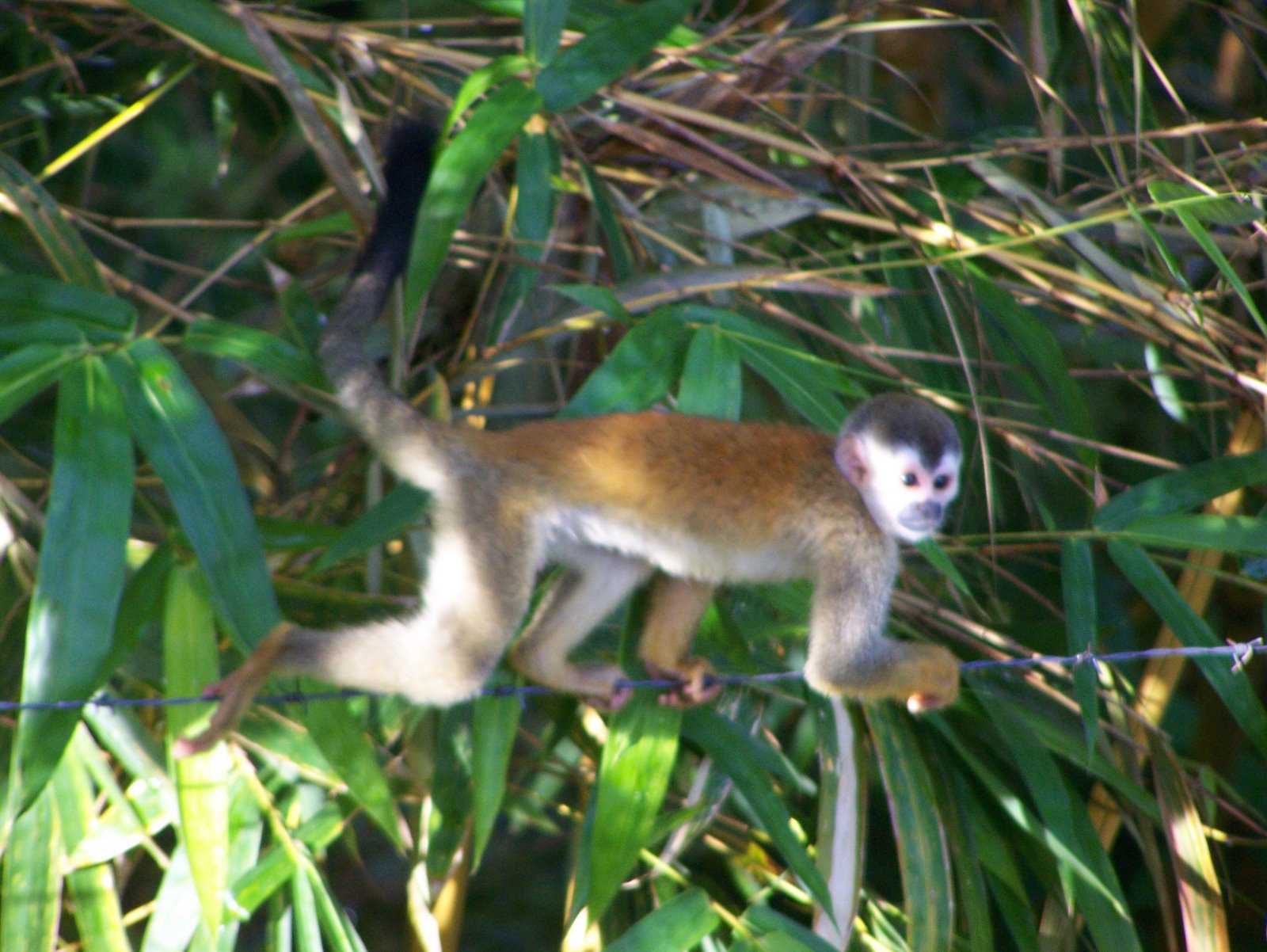|
Manuel Antonio National Park
Manuel Antonio National Park ( es, Parque Nacional Manuel Antonio) is a small national park in the Central Pacific Conservation Area located on the Pacific coast of Costa Rica, just south of the city of Quepos, Puntarenas, and from the national capital of San José. Established in 1972, the local community sought conservation to prohibit development of the natural environment for tourist attraction. They also protested the beach restrictions on locals by foreign owners. With a land area enumerating 1,983 ha, it is the smallest of any Costa Rican national park. The park caters to as many as 150,000 visitors annually, and is well known for its beautiful beaches and hiking trails. In 2011, Manuel Antonio was listed by ''Forbes'' as among the world's 12 most beautiful national parks. Features of the park This park has impressive landscapes and several coves with many white-sand beaches and lush foliage amidst great mountains and forests that reach the beaches. Additionally, it ... [...More Info...] [...Related Items...] OR: [Wikipedia] [Google] [Baidu] |
Costa Rica
Costa Rica (, ; ; literally "Rich Coast"), officially the Republic of Costa Rica ( es, República de Costa Rica), is a country in the Central American region of North America, bordered by Nicaragua to the north, the Caribbean Sea to the northeast, Panama to the southeast, the Pacific Ocean to the southwest, and Maritime boundary, maritime border with Ecuador to the south of Cocos Island. It has a population of around five million in a land area of . An estimated 333,980 people live in the capital and largest city, San José, Costa Rica, San José, with around two million people in the surrounding metropolitan area. The sovereign state is a Unitary state, unitary Presidential system, presidential Constitution of Costa Rica, constitutional republic. It has a long-standing and stable democracy and a highly educated workforce. The country spends roughly 6.9% of its budget (2016) on education, compared to a global average of 4.4%. Its economy, once heavily dependent on agricultu ... [...More Info...] [...Related Items...] OR: [Wikipedia] [Google] [Baidu] |
Bird
Birds are a group of warm-blooded vertebrates constituting the class Aves (), characterised by feathers, toothless beaked jaws, the laying of hard-shelled eggs, a high metabolic rate, a four-chambered heart, and a strong yet lightweight skeleton. Birds live worldwide and range in size from the bee hummingbird to the ostrich. There are about ten thousand living species, more than half of which are passerine, or "perching" birds. Birds have whose development varies according to species; the only known groups without wings are the extinct moa and elephant birds. Wings, which are modified forelimbs, gave birds the ability to fly, although further evolution has led to the loss of flight in some birds, including ratites, penguins, and diverse endemic island species. The digestive and respiratory systems of birds are also uniquely adapted for flight. Some bird species of aquatic environments, particularly seabirds and some waterbirds, have further evolved for swimming. B ... [...More Info...] [...Related Items...] OR: [Wikipedia] [Google] [Baidu] |
Woodpecker
Woodpeckers are part of the bird family Picidae, which also includes the piculets, wrynecks, and sapsuckers. Members of this family are found worldwide, except for Australia, New Guinea, New Zealand, Madagascar, and the extreme polar regions. Most species live in forests or woodland habitats, although a few species are known that live in treeless areas, such as rocky hillsides and deserts, and the Gila woodpecker specialises in exploiting cacti. Members of this family are chiefly known for their characteristic behaviour. They mostly forage for insect prey on the trunks and branches of trees, and often communicate by drumming with their beaks, producing a reverberatory sound that can be heard at some distance. Some species vary their diet with fruits, birds' eggs, small animals, tree sap, human scraps, and carrion. They usually nest and roost in holes that they excavate in tree trunks, and their abandoned holes are of importance to other cavity-nesting birds. They sometimes com ... [...More Info...] [...Related Items...] OR: [Wikipedia] [Google] [Baidu] |
Toucan
Toucans (, ) are members of the Neotropical near passerine bird family Ramphastidae. The Ramphastidae are most closely related to the American barbets. They are brightly marked and have large, often colorful bills. The family includes five genera and over forty different species. Toucans are arboreal and typically lay 2–4 white eggs in their nests. They make their nests in tree hollows and holes excavated by other animals such as woodpeckers—the toucan bill has very limited use as an excavation tool. When the eggs hatch, the young emerge completely naked, without any down. Toucans are resident breeders and do not migrate. Toucans are usually found in pairs or small flocks. They sometimes fence with their bills and wrestle, which scientists hypothesize they do to establish dominance hierarchies. In Africa and Asia, hornbills occupy the toucans' ecological niche, an example of convergent evolution. Taxonomy and systematics The name of this bird group is derived from the ... [...More Info...] [...Related Items...] OR: [Wikipedia] [Google] [Baidu] |
Snake
Snakes are elongated, Limbless vertebrate, limbless, carnivore, carnivorous reptiles of the suborder Serpentes . Like all other Squamata, squamates, snakes are ectothermic, amniote vertebrates covered in overlapping Scale (zoology), scales. Many species of snakes have skulls with several more joints than their lizard ancestors, enabling them to swallow prey much larger than their heads (cranial kinesis). To accommodate their narrow bodies, snakes' paired organs (such as kidneys) appear one in front of the other instead of side by side, and most have only one functional lung. Some species retain a pelvic girdle with a pair of vestigial claws on either side of the cloaca. Lizards have evolved elongate bodies without limbs or with greatly reduced limbs about twenty-five times independently via convergent evolution, leading to many lineages of legless lizards. These resemble snakes, but several common groups of legless lizards have eyelids and external ears, which snakes lack, altho ... [...More Info...] [...Related Items...] OR: [Wikipedia] [Google] [Baidu] |
White-nosed Coati
The white-nosed coati (''Nasua narica''), also known as the coatimundi (), is a species of coati and a member of the family Procyonidae (raccoons and their relatives). Local Spanish names for the species include ''pizote'', ''antoon'', and ''tejón'', depending upon the region. It weighs about . However, males are much larger than females: small females can weigh as little as , while large males can weigh as much as . Wc.pima.edu. Retrieved on 2011-09-15. On average, the nose-to-tail length of the species is about with about half of that being the tail length. Distribution and habitat  The white-nosed ...
The white-nosed ...
[...More Info...] [...Related Items...] OR: [Wikipedia] [Google] [Baidu] |
Common Basilisk
The common basilisk (''Basiliscus basiliscus'') is a species of lizard in the family Corytophanidae. The species is endemic to Central America and South America, where it is found near rivers and streams in rainforests. It is also known as the Jesus Christ lizard, Jesus lizard, South American Jesus lizard, or ''legarto de Jesus Cristo'' for its ability to run on the surface of water. Description The common basilisk can be distinguished from similar species within its range by its large size and the high fin-like crest along its back. Most common basilisks are brown and cream in color. Males also have high crests on the head and tail. Both sexes are brown to olive, and have a white, cream, or yellow stripe on the upper lip and a second stripe along either side of the body; these stripes have higher contrast in juveniles and fade as the lizards age. Hatchlings weigh a mere and are long. Adults can grow to a total length (including tail) of 76 cm (2.5 feet). Females are gen ... [...More Info...] [...Related Items...] OR: [Wikipedia] [Google] [Baidu] |
Black Spiny-tailed Iguana
''Ctenosaura similis'', commonly known as the black iguanaLiner, Ernest A. and Gustavo Cass-Andreu. (2008). ''Standard Spanish, English and Scientific Names of the Amphibians and Reptiles of Mexico (2nd. ed.).'' Herpetological Circular No. 38. Society for the Study of Amphibians and Reptiles. iv, 162 pp. or black spiny-tailed iguana, is a lizard native to Mexico and Central America. It has been reported in some Colombian islands in the Caribbean Sea and Pacific Ocean, and has been introduced to the United States in the state of Florida. It is the largest species in the genus ''Ctenosaura''. They are typically found in areas such as grasslands and forests. Taxonomy The black spiny-tailed iguana was first described by British zoologist John Edward Gray in 1831. The generic name, ''Ctenosaura'', is derived from two Greek words: ''ctenos'' (Κτενός), meaning "comb" (referring to the comblike spines on the lizard's back and tail), and ''saura'' (σαύρα), meaning "lizard". ... [...More Info...] [...Related Items...] OR: [Wikipedia] [Google] [Baidu] |
Panamanian White-faced Capuchin
The Panamanian white-faced capuchin (''Cebus imitator''), also known as the Panamanian white-headed capuchin or Central American white-faced capuchin, is a medium-sized New World monkey of the family Cebidae, subfamily Cebinae. Native to the forests of Central America, the white-faced capuchin is important to rainforest ecology for its role in dispersing seeds and pollen. Among the best known monkeys, the Panamanian white-faced capuchin is recognized as the typical companion to the organ grinder. In recent years the species has become popular in United States, American media, particularly in the ''Pirates of the Caribbean (film series), Pirates of the Caribbean'' film series. It is a highly intelligent monkey and has been trained to assist paraplegic persons. It is a medium-sized monkey, weighing up to . It is mostly black, but with a pink face and white on much of the front part of the body, giving it its common name. It has a distinctive prehensile tail that is often carried ... [...More Info...] [...Related Items...] OR: [Wikipedia] [Google] [Baidu] |
Central American Squirrel Monkey
The Central American squirrel monkey (''Saimiri oerstedii''), also known as the red-backed squirrel monkey, is a squirrel monkey species from the Pacific coast of Costa Rica and Panama. It is restricted to the northwestern tip of Panama near the border with Costa Rica, and the central and southern Pacific coast of Costa Rica, primarily in Manuel Antonio and Corcovado National Parks. It is a small monkey with an orange back and a distinctive white and black facial mask. It has an omnivorous diet, eating fruits, other plant materials, invertebrates and some small vertebrates. In turn, it has a number of predators, including raptors, cats and snakes. It lives in large groups that typically contain between 20 and 75 monkeys. It has one of the most egalitarian social structures of all monkeys. Females do not form dominance hierarchies, and males do so only at breeding season. Females become sexually mature at years, and males at 4 to 5 years. Sexually mature females leave the natal ... [...More Info...] [...Related Items...] OR: [Wikipedia] [Google] [Baidu] |
Mantled Howler
The mantled howler (''Alouatta palliata'') is a species of howler monkey, a type of New World monkey, from Central and South America. It is one of the monkey species most often seen and heard in the wild in Central America. It takes its "mantled" name from the long guard hairs on its sides. The mantled howler is one of the largest Central American monkeys, and males can weigh up to . It is the only Central American monkey that eats large quantities of leaves; it has several adaptations to this folivorous diet. Since leaves are difficult to digest and provide less energy than most foods, the mantled howler spends the majority of each day resting and sleeping. The male mantled howler has an enlarged hyoid bone, a hollow bone near the vocal cords, which amplifies the calls made by the male, and is the reason for the name "howler". Howling allows the monkeys to locate each other without expending energy on moving or risking physical confrontation. The mantled howler lives in groups ... [...More Info...] [...Related Items...] OR: [Wikipedia] [Google] [Baidu] |

.jpg)




